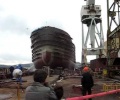
[ad_1]

Samsung Heavy Industries Co. last month successfully completed a sea trial of its self-operating vessel technology, which enables two autonomous ships to recognize each other and avoid a collision.
The South Korean shipbuilder aims to commercialize the remote autonomous system, called Samsung Autonomous Ship (SAS), next year to cement its leadership in the shipbuilding market.
Samsung is now believed to have entered the second stage of autonomous ship development, based on the standards of the International Maritime Organization (IMO), a UN maritime safety agency. In the second-stage development, a ship can recognize surrounding vessels and obstacles, while assessing the risk of collision, to find the optimal route.
“We will be able to enter the third-stage development if we build a standby system where we leave a minimum crew on the remote-control ship,” said Samsung Heavy’s shipbuilding and marine research head Kim Hyun-jo. “We are aiming to enter the third stage by 2025.”
The autonomous ship market is forecast to nearly double in size to 180 trillion won ($152 billion) by 2025, versus an estimated 95 trillion won this year, according to South Korea’s Ministry of Oceans and Fisheries.
“Self-operating ships are a game-changer in the shipbuilding industry,” Samsung Heavy’s Kim added. “To further develop our shipbuilding and IT industries, the relevant institutions and government ministries need to cooperate.”
A majority of the world’s leading shipbuilders are in between the first and second stages of autonomous ship technology development, with some European countries such as Finland and Norway at the forefront of the development.
The European Union has since 2012 been working on an unmanned ship research project, dubbed MUNIN, or Maritime Unmanned Navigation through Intelligence in Networks. Finland in 2018 succeeded in undertaking a 2.4km sea trial of its autonomous vessel.
Samsung recently made public its autonomous ship operation system of SAS and the data-collecting platform, named SVESSEL, to the media.
SAS uses an onboard computer that collects data on the route, speed, fuel consumption and maintenance. It adjusts its sails to the change in the weather and water conditions. The autonomous operation is supervised through the screen of the inland control tower, communicating with the vessel 24 hours a day.
TASKS AHEAD
To ensure smooth real-time communication and data transmission with other ships and the remote operation center, the next task for Samsung is to build an infrastructure for multiple different radio technologies such as satellites, mobile networks and dedicated narrowband systems.
In particular, the company needs to increase the speed of data transfer between the onboard navigator and the remote control tower, key for making quick decisions in emergency situations, according to a company source.
Samsung is also upgrading the autonomous control systems to prepare for various scenarios because sailing conditions differ between oceans and coasts.
Samsung Heavy has the world’s largest towing tank, 400 meters in length and 14m in width. The shipbuilder had built a test platform for its first-generation self-operating model ship Easy Go in the towing tank in 2019, before conducting a sea trial.
CYBER SECURITY
To protect the vessel’s automation systems from cyberattacks that manipulate navigation, steering, or propulsion systems, Samsung Heavy is developing cybersecurity solutions together with its sister company Samsung SDS Co.
Meanwhile, Hyundai Heavy Industries Co., the world’s largest shipbuilder, plans to commercialize leisure boats with autonomous navigation systems next year. Its in-house startup Avikus is developing artificial intelligence-based remote control technology for ships.
Regarding remote-controlling ship technology, Daewoo Shipbuilding & Marine Engineering Co. this month received a cybersecurity design assessment certificate for its smart ship platform from ABS, a US ship quality assurance and risk management company.
Source: The Korea Economic Daily
[ad_2]
This article has been posted as is from Source